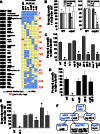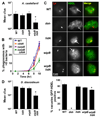Aggravating genetic interactions allow a solution to redundancy in a bacterial pathogen
- PMID: 23239729
- PMCID: PMC3780440
- DOI: 10.1126/science.1229556
Aggravating genetic interactions allow a solution to redundancy in a bacterial pathogen
Abstract
Interactions between hosts and pathogens are complex, so understanding the events that govern these interactions requires the analysis of molecular mechanisms operating in both organisms. Many pathogens use multiple strategies to target a single event in the disease process, confounding the identification of the important determinants of virulence. We developed a genetic screening strategy called insertional mutagenesis and depletion (iMAD) that combines bacterial mutagenesis and RNA interference, to systematically dissect the interplay between a pathogen and its host. We used this technique to resolve the network of proteins secreted by the bacterium Legionella pneumophila to promote intracellular growth, a critical determinant of pathogenicity of this organism. This strategy is broadly applicable, allowing the dissection of any interface between two organisms involving numerous interactions.
Figures




References
-
- Nguyen TM, et al. A community-wide outbreak of Legionnaires disease linked to industrial cooling towers-how far can contaminated aerosols spread? J. Infect. Dis. 2006;193:102. - PubMed
Publication types
MeSH terms
Substances
Grants and funding
LinkOut - more resources
Full Text Sources
Other Literature Sources
Medical
Molecular Biology Databases

